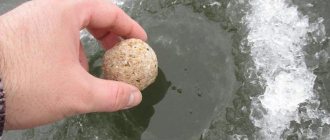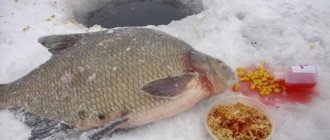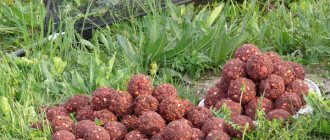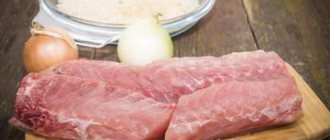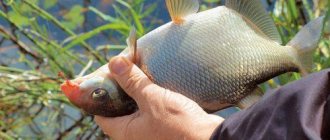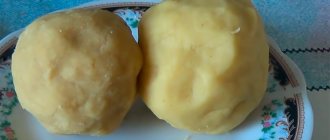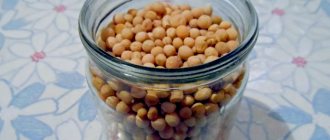Sometimes anglers do not know how to prepare peas for bream fishing correctly, so they rarely use this excellent bait. Bream loves peas; in some reservoirs in the summer you can catch large fish only with the help of such a bait. This attachment helps out when, due to the dominance of small fish, it is impossible to catch with a worm or maggot. Catching bream requires a certain approach to feeding and using baits. Let's look at how to cook peas for bream for baiting and feeding.
Peas for bream
Pea seeds contain a large amount of protein, and fish sense this. Properly prepared, it often works better than the usual corn or pearl barley. Preparation requires some fiddling, so this bait is used less often by fishermen. Bream is one of the obvious connoisseurs of this bait, along with crucian carp and carp. In some reservoirs, fishing for bream with peas is the only possible way to catch fish, especially in the summer, when small slugs simply do not allow the worm to wait for a large fish to approach the hook.
An important feature of bream fishing is that the bait components match the bait used on the hook. If we fish with peas, then this component must also be present in the bait. For bait, whole unshelled peas, regular or larger chickpeas (chickpeas) are used. You can also add whole grains to the bait, but not much - otherwise it will be difficult for the fish to find a hook with a bait in the middle of a clearing covered with large food particles. It is better to cook ordinary split polished peas from a department store as bait for bream, or crush whole ones into porridge. Preparing such a bait requires attention and time, but it pays off in the reservoir with good catches.
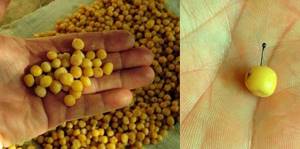
Spring porridge recipes for various types of fish
Porridge for crucian carp
Crucian carp, found in many domestic reservoirs, is the most popular prey. Corn porridge prepared in accordance with the following recipe is well suited for catching it:
- Pour corn kernels into a pan of water and add one teaspoon of granulated sugar.
- The corn is cooked for 2 hours; it should be stirred periodically with a spoon.
- The resulting mass should be cooled to a comfortable temperature, then passed through a meat grinder and mixed with cat or dog food.
- You can use a small amount of anise seeds, vanillin or grated garlic as a flavoring.
Porridge for carp
The spring is very often used if the main target of fishing is carp; in this case, you can prepare the following porridge:
- 800g of dry peas are poured into the pan; they need to be cooked until a homogeneous liquid mass is formed.
- While the mass is cooling, take one bag of fried sunflower seeds and pass through a meat grinder.
- Add 400g of semolina in small portions to the cooled pea mixture, while simultaneously stirring the mixture with a spoon.
- Mixing should be continued until the mass in its structure begins to resemble hard dough; immediately after this, crushed seeds are poured into it.
- The porridge is thoroughly mixed again.
Porridge for bream
There are various options for porridge designed for catching bream, but the most effective bait is prepared according to the following recipe:
- Three full glasses of water are poured into the pan, after which it is brought to a boil.
- Several glasses of pearl barley are poured into boiling water; cooking should be accompanied by constant stirring and continue until the cereal swells.
- One glass of millet, a tablespoon of sunflower oil and a small amount of vanillin are added to the composition.
- Cooking continues until the millet absorbs the remaining water: this will be indicated by the appearance of bubbling holes on the surface.
- The pan is removed from the heat and covered with a lid; The porridge must be allowed to sit for half an hour.
- After the specified period has expired, the bait is transferred to a clean pan, one glass of semolina and two glasses of barley and corn grits are added to it.
- The mass is thoroughly mixed, after which an effective bait for catching bream with a spring is ready.
Whole peas for bait
To attach the hook, whole grains with skins are used, prepared by boiling or steaming, as well as mastyrka, which is a plasticine-like mass. Fish respond well to the smell of peas, no matter how they are cooked. For gear for bream that requires long casting and with active small fish, it is better to use whole grain peas - they simply stay on the hook better, and small fish are not able to swallow them and knock down the bait. On float gear, a softer, dough-like consistency is often used.
To catch bream using peas on the river, you also need to use whole grain, since the mastyrka is washed out over time. There are two ways to prepare peas for bream - boiled or steamed. To steam peas for bream fishing, you need young grains, no older than six months - they boil quickly. The older one needs to be boiled. And this is the most common cooking method. Let's look at how to properly prepare peas for catching bream.
Choosing cereals
Whole unshelled peas are not easy to find in the store. In a department store you may find chickpeas, our larger cousin. However, in terms of cheapness, it is better to look for this product in pet food stores. It is better to stock up in large quantities at once, for example, a bag for a year. This amount is enough for many fishing trips. Peas are perfectly stored and do not lose their properties. It’s just that the older the grain, the longer it will have to be cooked. Steaming in boiling water only works with relatively young grain.
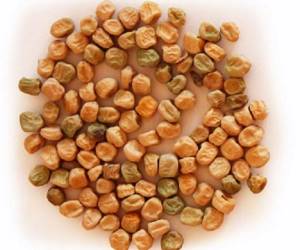
Whole pea grains can also be found on the market. It is better to choose wrinkled peas. Cook it longer. But it does not boil over, and during the cooking process it turns into good whole peas with intact skin, which is what is required for fishing. The seed is available in green, white or orange. For bait, we take white, orange, wrinkled whole peas or large chickpeas (this is even better for large fish - the diameter of the finished grain is 6-8 mm, and for a regular one it is 4-6 mm).
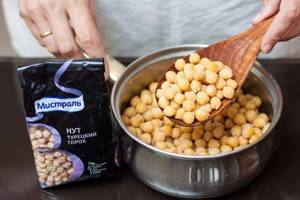
Soaking
Before you cook peas for bream fishing, you need to soak them. The soaking process is required. If you do not do this and cook immediately, the structure of the grain will be disrupted, the skin will burst, and the peas will fall apart. And it will take several hours to cook unsoaked peas. After soaking, the cooking process takes from half an hour to an hour and a half, depending on the age of the seeds.
To soak our future bait, we thoroughly rinse the seed in water and place it in a container with a third of its volume. It could be a can, a bottle, or anything. An approximate calculation is a liter of finished bait (for one rod). This is enough for baiting and adding to bait. When soaked, the peas, taking in water, increase in volume by about 3 times. Thus, to get a liter jar of finished bait, for soaking we take 1/3 of the total volume of seeds and fill it with water until full.
You need to insist for about 12 hours or more, at a temperature no higher than room temperature. In hot weather, peas may begin to sour. Therefore, in the warm season, it is better to put it in the refrigerator for soaking. After about 8-12 hours, the seeds will absorb water, swell and fill the entire volume. You can pour the grain for soaking into plastic bottles and store it in this form in the refrigerator for weeks. This is convenient - if necessary, we take an already soaked product for cooking. This way you can reduce the cooking time.
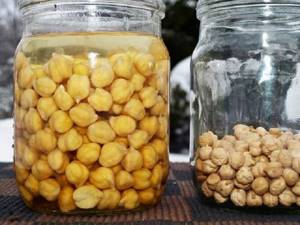
Cooking
Next, the most important thing is how to properly cook peas for bream fishing. Pour our semi-finished product from the jar into the pan, along with some water. Add water two fingers above the grain (more is possible) and put it on fire. To catch crucian carp at this stage, you can throw a clove of garlic into the pan. However, this aroma does not always affect bream, mostly in cold water. For bream, it is better to add a couple of tablespoons of sugar and a pinch of salt to the pan. The pea aroma itself is a great attractor for bream and carp.
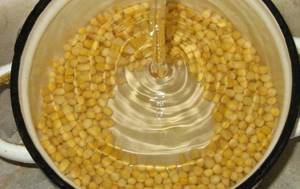
Set the heat to medium, bring to a boil and cook until done. Whole seeds are covered with a thin film, which should not be damaged during the cooking process. Ready peas are pureed inside. The bait is held on the hook by this dense outer layer. The main task when cooking is to ensure that the middle is boiled, and the outer shell remains strong enough and does not fall apart or burst. Stir gently during the cooking process - under no circumstances allow it to burn. And the flip side is that you should not allow changes in the temperature and intensity of boiling, or reduce the heat. As we put it at first, we keep it until the end of the process. Cooking requires attention, it can take up to an hour and a half, but usually from 40 minutes to an hour. We taste readiness with our fingers. The finished pea is whole. But when pressed, it flattens, squeezing out the soft inner part.
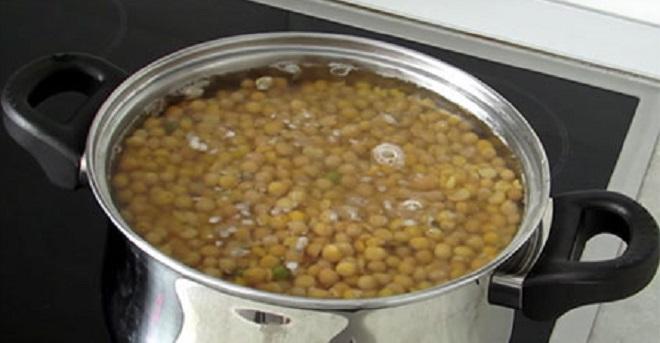
When the bait is ready, carefully drain the water and wait a while for it to cool. You can put it on a cloth and dry it a little. You cannot dry it for a long time - the bait will begin to release water and lose its properties. That's all - the best vegetable bait for bream and other large fish of the carp family is ready. We put it in a bag, a jar with a lid and go fishing. We use a small part as a bait, the rest is added to the bait for bream as a feed fraction. After soaking, young peas can not be boiled, but steamed in a thermos, like wheat, or in a saucepan of boiling water, wrapped in a towel.
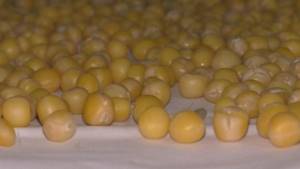
How to choose boiled peas for fishing?
Some may think that the question makes no sense. Why choose again if you can take it and cook it? Rather, you need to be interested in which recipe to choose to create the ideal bait. We urge you not to rush, because there is one nuance: you can cook porridge and use it to make bait, you can prepare mastyrka or a similar bait based on flour, and finally, you can simply steam peas. All these options have one thing in common - they use already dried legumes. And each of them deserves consideration - let's start with the last one.
How to steam peas
This can be done both in a thermos and without it. The first option is convenient because the nozzle is prepared in 3-4 hours, so let's look at it first. So, to steam, you need to pour boiling water over the thermos (from the inside, of course), fill it with washed peas about a third and fill it with hot water to the brim. That's it, now you just need to leave the future attachment for several hours. Just keep in mind that with this method of steaming the peas may soften too much.
Therefore, the second option is preferable if you have time, if you are preparing for fishing in a few days, not hours (which is exactly what you need to do). To steam peas without a thermos, leave them in cool water overnight. The container can be an ordinary saucepan. Then in the morning you need to drain the cold water, fill the dish with hot water and put it on the fire. Next, you need to bring the peas to a boil over low heat, turn off and let stand for 8-10 minutes. Then you need to remove the pan from the stove and let the future attachment brew for another half hour. The bait will be tasty and dense enough not to fly off the hook.
Peas for bream in bait
The next task is to make groundbait based on peas. As already mentioned, the main secret of how this bait works is working in pairs. It must be present on the hook and in the bait at the same time. It’s easier with bait - you don’t need to worry about the integrity of the grain. On the contrary, you don’t need a lot of whole grains for bream (this will distract the fish’s attention from the bait). If there is a lot of whole cooked chickpeas, then most of them can simply be twisted into porridge and added to the mass - the pea bait for bream is ready.
If there are not enough whole grains, you can cook them a little for attachment. For bait, we prepare ordinary pea porridge for bream fishing from half-polished grain from the store. The process is similar to preparing whole grains - soak for 8-12 hours, then cook, only not so thoroughly, but completely, until pureed. We then use this mass to add to bait or to prepare pea mastyr for bait on a fishing rod. Mastyrka is usually used for fishing rods if there are no intact unhulled grains. Even on a float fishing rod, whole grains work better - the bait stays on the hook better and is not eaten away by small things.
During the cooking process, when the peas begin to fall apart, you can add millet to them. Cook for another 10-15 minutes, and we get the basis for baiting bream from peas and millet. Groundbait made from this ingredient also contains a middle fraction - millet grains. The process of further mixing depends on the conditions and for what gear the bait will be used.
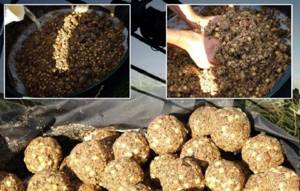
How to choose fresh peas for fishing and put them on the hook correctly
Everything is simple here: you need to give preference to recently ripened peas that have not yet had time to harden.
It is still soft and inserting a hook into it will not be difficult. And the taste of young peas is better, there is sweetness, and the aroma is stronger. Recognizing it among others (if you buy it) is not difficult - focus on the color of the pod. The greener and brighter it is, the younger the peas. That's out of the way, now let's move on to fitting and answer how to make it easy and quick. Again, everything is simple: each pea has an eye - a speck that stands out for its brightness. It is through this that you need to thread the hook tip. By the way, it is better to use peas whole rather than halved. In this case, the tip of the hook can be either hidden or brought out - it all depends on the fish. If potential prey behaves cautiously, it is worth drowning the sting in a pea. Well, you don’t have to bother with greedy people and take the sting out.
Feeder and bottom fishing
When prepared, pea bait for bream for feeder fishing should mold well, but fall apart when pressed. This is due to the special tactics of the feeder - frequent recasts and constant feeding of one point. Therefore, we break up pea puree or porridge with a loose, small component - breadcrumbs, ground cake or store-bought mixtures. As a result, we get a fairly loose mixture, which molds when compressed to fill the feeder.
When fishing for bream in the current, you need a more viscous mixture so that it does not wash out immediately. But still, it should not lie like a dead weight at the bottom, but over time collapse and release the feeder. The right pea bait for bream in summer can also attract large crucian carp and carp to the point. Be sure to add a certain amount of large whole grains to the mixture for bream, as on a hook, so that the fish begins to eat them and purposefully search for them among the small particles of the rest of the feeding. We do the same with millet and pea porridge for feeder fishing. Read more about feeder bait for bream.
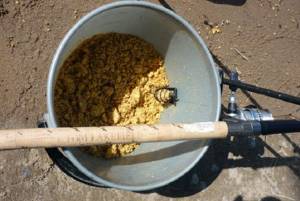
You can prepare and boil peas while fishing for bream for bait and bait right on the pond, on a fire, or during multi-day trips. It’s just that in the heat, after one day of fishing, the pre-prepared bait and bait may deteriorate. In some reservoirs it has been noticed that bream and carp react well only to fresh, recently cooked peas.
The consistency of bream bait for donks, when hammering it into springs, watermelons or nipples, requires a more viscous consistency, similar to plasticine. The main tactics of donkeying are casting and waiting. Therefore, the porridge should not be washed out quickly, waiting for the bream to approach. Therefore, we mix a few small components into this fertilizing, just to remove excess moisture. All these mixtures can also be used when fishing for bream with a ring from a boat.
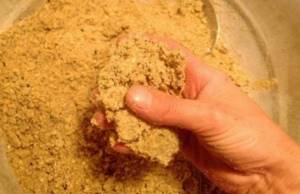
Recipe and preparation of homemade winter bream bait with a slight pea flavoring
In winter, the water in the reservoir becomes quite clear. That is why winter bait is designed not only to feed the fish, but also to create a certain cloudy column in the water.
To prepare winter bream bait you need:
- breadcrumbs – 800 g;
- roasted sunflower seeds – 90 g;
- oat flakes – 100 g;
- polished split peas – 250 g.
Stage 1. Cook pea porridge
To do this, add peas to a pan of boiling water. There should be twice as much water as peas. Bring to a boil and simmer over low heat with the lid ajar (or use a lid with a valve). It needs to simmer for quite a long time. The peas should boil into porridge.
Step 2: Preparing Dry Ingredients
Breadcrumbs can be used either store-bought or homemade. The price of breadcrumbs in the store is quite high. It is for this reason that you can often find woven bags with crackers in fishermen’s houses (near the radiator or on the balcony). To prepare crackers, use leftover bread, loaf, cookies, crackers, etc. Simply pass the crackers through a meat grinder.
Oatmeal (such as “Hercules”) is also passed through a meat grinder or crushed in a coffee grinder. It is oatmeal that will give a good white dregs.
The seeds can be bought roasted or raw. If you buy raw seeds, you will have to fry them (but they are cheaper). Pass the roasted seeds through a meat grinder or grind in a coffee grinder. The seeds have positive buoyancy. Thanks to this, the bait with them will form a cloudy column.
Pour all ingredients into a bowl and mix.
Stage 3. Final stage of preparation
Pour pea porridge into the bowl with the dry ingredients.
Knead the mixture with your hands. It will turn out a little dry. Pour all the bait into the bag. The crackers will absorb some liquid, swell and become soft. The finished bait should easily mold into a lump, which should disintegrate with gentle pressure.
Winter bream bait is ready
The bait is ready. All that remains is to get ready to go fishing. When fishing, it is possible (and better) to add feed bloodworms (100 g or more) to the bait. In those fishing areas where there is jig, raw or boiled jig, or a mixture of live and boiled jig, is added to this bait - this option is preferable for winter night fishing for bream in a tent.
Starter feeding is carried out using dump truck feeders (you can use homemade ones of the size you need) or a stationary feeder is installed downstream.
There is the possibility of both complementary feeding and additional feeding with balls of various sizes directly into the hole. Although, it is worth noting that this feeding method is more preferable when fishing for roach, and is often contraindicated when fishing for bream.
Ekaterina and Vitaly Danilov, Belarus, Borisov - Especially for the site Homemade products for fishing with your own hands
samodelkifish.ru
Float fishing
On small rivers, lakes and from a boat, you can also catch bream using a float, if the depth and current allow. In this case, feeding is done with balls directly into the fishing area. To do this, you can use either porridge or throw whole grains in bulk into the fishing zone. Naturally, the strength of the current is taken into account. The hook with the nozzle must be located in the feeding spot on the bottom, otherwise the bream that comes up for bait will not find the nozzle lying alone on the side. We place whole boiled peas or mastyrka on the hook. The consistency of pea bait for bream for a float is selected based on the fishing conditions. On lakes where there is no current, a crumbly mixture is needed, as for a feeder.
You need to adjust the consistency so that the balls reach the bottom intact and begin to fall apart on the spot. If they become very dusty in the depths, they are more likely to attract roach rather than bream. In a current, a more viscous consistency is needed in order to slowly fall apart at a point and form a stern plume in the direction of the flow. Preparing peas for bream fishing should always be thoughtful and based on the upcoming fishing features and the gear used.
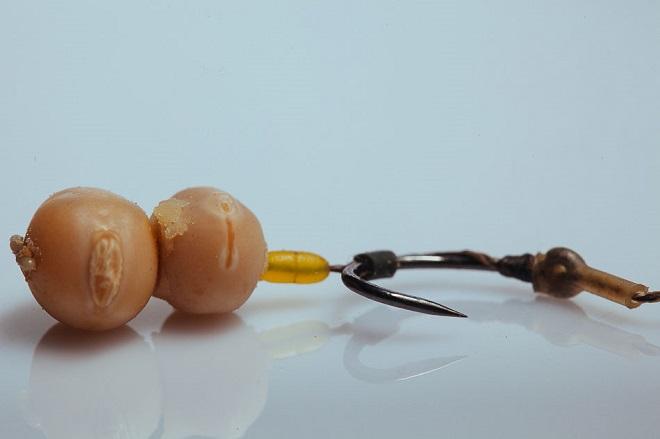
Hair rig
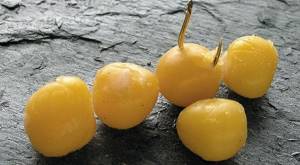
Canned or young peas
In float fishing, you can use canned or live young peas from the bush. This bait easily gets knocked off the hook, so it is not used on long-distance casting gear. You can use canned peas for bream when fishing carefully with a fishing rod. Such bait can usually be pecked in summer in warm water. If there is no dominance of small fish that quickly knock down this delicate bait, its use is justified. If you don’t want to bother with cooking, then it’s better to buy ready-made boiled whole peas for fishing, and add porridge to the bait.
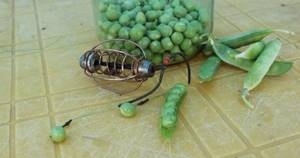
Recipes for the best porridges for spring
Millet porridge for fishing on a nipple
Millet is one of the most popular cereals, since it is a universal bait that bites most species of fish; Most often it is used for catching tench, carp, roach or crucian carp.
The recipe is quite simple:
- Pour a glass of water into a container and keep it over low heat until it boils.
- Pour several cups of cereal into boiling water.
- The cooking process takes no more than 15 minutes, during which time the porridge must be constantly stirred with a spoon.
- After the specified period of time, remove the container from the heat and allow the millet to settle a little.
- It is allowed to add a small amount of feed to improve viscosity.
Pea porridge for spring fishing
The recipe for pea porridge is also quite simple, but the cooking process itself is more expensive. The result will be a universal bait that can interest many species of fish.
You can prepare it in the following way:
- Pour a liter of water into a container and add 200g of peas, then put it on the stove and reduce the heat to low.
- Let the mixture come to a boil, stirring it to avoid sticking to the pan.
- After boiling, you need to carefully remove the resulting foam and leave the mixture on low heat for another 10 minutes.
- After 10 minutes, you can turn up the heat, but cover the porridge with a lid.
- After 5 minutes, no more than half a teaspoon of baking soda is added to the composition, after which the porridge must be thoroughly mixed to evenly distribute this component.
- If all the described actions are followed, the peas should turn into a liquid mass, to which 100 grams of millet cereal is added.
- After 10 minutes of cooking, add one teaspoon of granulated sugar and a third of a teaspoon of table salt. This will make the bait more appetizing, which will increase the chances of a catch.
- If desired, you can add a small amount of sunflower cake to the composition.
Mamalyga (corn porridge) for fishing with a spring
Mamalyga is a corn porridge that is easy to prepare and can provide an active bite; It is usually used when fishing for tench, ide, crucian carp, roach or rudd.
The recipe is detailed below:
- Initially, you will need to take a hot frying pan and fry 300g of corn flour in it, placing it on high heat. Frying should take no more than 3 minutes; the flour should be stirred constantly.
- At the second stage, you can add 100g of wheat flour and heat the mixture for a few more minutes.
- The fried flour is gradually poured with water; this can only be done by first reducing the heat to a minimum.
- After 10 minutes, the porridge should become thick and viscous; now, at your discretion, you can add sunflower cake or a very small amount of vanillin.
- The porridge should be removed from the heat and allowed to cool slightly, then divided into two equal portions and placed in plastic bags that are sealed tightly.
- The bags are placed in a pan, into which a liter of water is poured, after which the bait is cooked for half an hour.
- Corn porridge can be left in the same container overnight and the water drained in the morning. The resulting bait, depending on its consistency, can be cut with a knife or formed into balls, which are then placed in a spring.
Porridge from mixed feed for spring fishing
This bait is based on a mixture of raw materials from different grain crops; special attention must be paid to the preparation process, otherwise you will end up with a liquid porridge, which the current will quickly wash out of the tackle.
It can be used for catching rudd, crucian carp or crucian carp; The recipe is given below:
- You will first need to prepare the potatoes by boiling them in their skins.
- Pour 2 liters of water into a saucepan, put it on the fire and wait until it boils.
- Add 0.5 kg of feed and cook for 5-10 minutes, continuously stirring the mixture.
- Add crumb taken from a loaf of rye bread to the composition.
- Select the two largest potatoes, crush them to a puree and add to the composition.
- Pour one tablespoon of sunflower oil into the porridge, then mix it thoroughly.
- A very small amount of vanillin can be used as an additional ingredient.
Semolina porridge with rolled oats on a spring
Another universal bait is semolina porridge with the addition of rolled oats; it attracts all types of fish that can distinguish odors in the water.
To prepare it, it is recommended to use the following instructions:
- Take two identical glasses - fill one halfway with semolina, and pour water into the other so that its level is a few millimeters higher.
- Water is poured into the pan and brought to a boil.
- Oatmeal is poured into boiling water; the proportion must be observed: one teaspoon for every half glass of water.
- One teaspoon of granulated sugar is added, after which the mixture is thoroughly mixed.
- You need to wait until white foam appears on the surface, after which you can begin to gradually add the pre-prepared semolina, while still stirring the porridge.
- After absorbing the liquid, the mass should be carefully pressed down on top, the container should be wrapped in a towel or blanket and the porridge should be allowed to settle for 15 minutes.
- After the specified period, you should rinse the mass again so that no distinguishable fractions of the cereal remain in it.
- A small amount of anise oil can be used as an aromatic additive.
Fermented peas
Fermented peas are used less frequently. Some anglers claim that fermented corn works well on fish, but sour peas work poorly. However, there is information that sometimes they bite well on fermented peas. It is better not to experiment with bream and fermentation - you can only scare away the fish. It has long been proven by experience that bream almost always and everywhere react positively to ordinary boiled peas. It is better to bother with fermentation when fishing for carp, carp or crucian carp.
